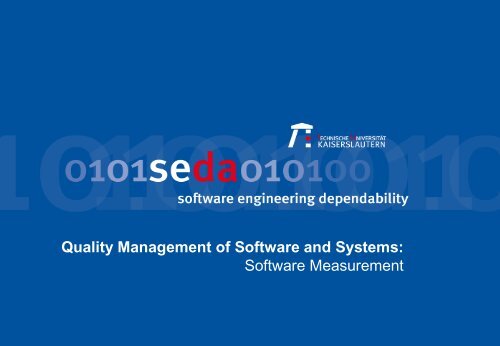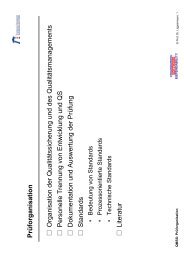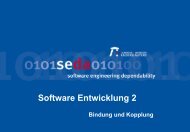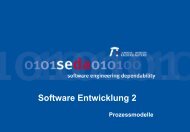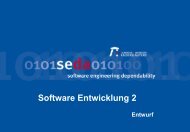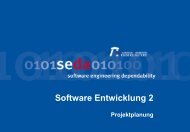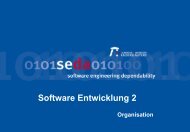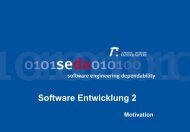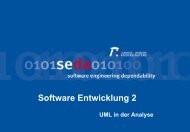Software Measures - Software Engineering: Dependability
Software Measures - Software Engineering: Dependability
Software Measures - Software Engineering: Dependability
You also want an ePaper? Increase the reach of your titles
YUMPU automatically turns print PDFs into web optimized ePapers that Google loves.
Quality Management of <strong>Software</strong> and Systems:<strong>Software</strong> Measurement
QMSS - <strong>Software</strong> Measurement© Prof. Dr. LiggesmeyerContents• Motivation• <strong>Software</strong> Quality Experiments• <strong>Software</strong> <strong>Measures</strong>• Measuring Scales• Cyclomatic Complexity• Current Impact of <strong>Software</strong> Measurements• <strong>Software</strong> Quality MeasurementQuality Management of <strong>Software</strong> and Systems:Reuse2
MotivationMeasurementQMSS - <strong>Software</strong> Measurement© Prof. Dr. Liggesmeyer• „When you can measure what you are speaking about, and express it in numbers,you know something about it; but when you cannot measure it, when you cannotexpress it in numbers, your knowledge is of a meager and unsatisfactory kind.“(Lord Kelvin, Popular Lectures and Addresses, 1889)• „Was man messen kann, das existiert auch!“(Max Planck, 1858 - 1947)3
MotivationMeasurements in <strong>Software</strong> Development• Substitutes qualitative and usually intuitive statements about software forquantitative and reproducible statements• Example• Qualitative, intuitive• The developer states: ‘I have fully tested my software module.’• Quantitative, reproducible• ‘My test tools states a branch coverage of 57% (70 of 123 branches) at the moment. In ourcompany modules are considered sufficiently tested with a branch coverage of 95%. Thus, Ihave to test at least 47 additional branches with an estimated additional effort of 1.5 days basedon experiences with similar modules.’4QMSS - <strong>Software</strong> Measurement© Prof. Dr. Liggesmeyer
Motivation: Measuring Quality in <strong>Software</strong>Development• Today, software is used in application domains, where quantitative statements arecommon or necessary• Contracts: ‘We stipulate a minimum availability of 99.8%!’• Safety proof of a rail system for the Federal Railway Authority (EBA): ‘What is the residual risk ofsoftware failures?’• Is the estimated number of residual faults sufficiently small to release the products?• Is the possibility of software faults in controllers causing a failure in our upper class limousinesufficiently small?• We need a failure free mission time of four weeks. Is this possible?5QMSS - <strong>Software</strong> Measurement© Prof. Dr. Liggesmeyer
Motivation: Measuring Quality in <strong>Software</strong>Development - Problems• Most quality characteristics not directly measurable!• Number of faults• Availability• Reliability• Safety• ...• Quality characteristics may be• Determined experimental (e.g., reliability)• Calculated from directly measurable characteristics (e.g., number of faults based on the measure ofcomplexity)6QMSS - <strong>Software</strong> Measurement© Prof. Dr. Liggesmeyer
<strong>Software</strong> Quality Experiments: StochasticAnalysis of <strong>Software</strong> Reliability - SituationQMSS - <strong>Software</strong> Measurement© Prof. Dr. Liggesmeyer• Independent research area since approximately 30 years• Sparse influence to software development in practice• Mathematical foundation partly too complex• A lot of different stochastic reliability models• A priori selection of a model not possible• Determination of model parameters necessary• Theory application to practice needs powerful tool support7
<strong>Software</strong> Quality Experiments: StochasticAnalysis of <strong>Software</strong> Reliability - TheoryQMSS - <strong>Software</strong> Measurement© Prof. Dr. Liggesmeyerm( t) E(N(t))• Musa and Goel-Okumoto model, respectivelybtm(t) a(1e )cbt• Generalized Goel-Okumoto modelm(t) a(1e )• Musa-Okumoto model• Generalized Musa-Okumoto model• Duane and Crow model, respectively• Log model• Log power model• Generalized log power model• Yamada S-shape model• Generalized Yamada S-shape modelm( t) aln(bt 1)cm( t) aln(bt 1)bm(t) atm( t) aln(bt )bm( t) aln( t 1)bm( t) aln( ct 1)m(t) a(1(1bt ) em(t) a(1(1ct)e• Geometric Moranda and deterministic proportional model, resp. m( t) a bln(t 1)• Littlewood modelbm(t) c(t a)• Inverse linear modelm( t) a(bt 11)8btbt))
QMSS - <strong>Software</strong> Measurement© Prof. Dr. Liggesmeyer<strong>Software</strong> Quality Experiments: Stochastic Analysisof <strong>Software</strong> Reliability - Practical Method of Resolution9
QMSS - <strong>Software</strong> Measurement© Prof. Dr. Liggesmeyer<strong>Software</strong> Quality Experiments: Stochastic Analysisof <strong>Software</strong> Reliability - Practical Method of Resolution• Numerous application domains (traffic engineering, medical engineering,telecommunication, ...)10
<strong>Software</strong> <strong>Measures</strong>Applying <strong>Measures</strong>QMSS - <strong>Software</strong> Measurement© Prof. Dr. LiggesmeyerProcess measuresProduct measuresAverageProductivityOn scheduleat phasetransitionsFunctionPointsTestCoverageAverage faultdetection ofinspectionsLOCCyclomaticNumberCurrent accumulated costsEstimated costsProject measures11
<strong>Software</strong> <strong>Measures</strong>Requirements of <strong>Measures</strong>• Simplicity• Is the result so simple that it could be easily interpreted?• Adequacy• Does the measure cover the desired characteristic?• Robustness• Is the value of the measure stable against manipulations of minor importance?• Timeliness• Can the measure be generated at a sufficient point in time to allow a reaction to the process?• Analyzability• Is the measure statistically analyzable (e.g., numeric domain) (For this requirement the type of themeasure scale is crucial)12QMSS - <strong>Software</strong> Measurement© Prof. Dr. Liggesmeyer
<strong>Software</strong> <strong>Measures</strong> : Requirements of<strong>Measures</strong> - ReproducibilityQMSS - <strong>Software</strong> Measurement© Prof. Dr. Liggesmeyer• Normally, a measure isreproducible, independent of thegeneration mechanism, if it isdefined in a precise wayProduct / ProcessManualgenerationof measuresTool-supportedgeneration ofmeasuresMeasuredvalue!Measuredvalue13
<strong>Software</strong> <strong>Measures</strong>: Requirements of<strong>Measures</strong> - Reproducibility• Examples• McCabe's cyclomatic number: e-n+2e = Number of edges in a CFG; n = Number of nodes in a CFG; CFG = Control flow graph• Completely reproducible• Lines of Code (LOC)Count empty lines? Count lines with comment?• Completely reproducible, if adequately defined• Function Points: manual evaluation of complexities needed• Not completely reproducible in principle• Understandability• Poor reproducibility14QMSS - <strong>Software</strong> Measurement© Prof. Dr. Liggesmeyer
<strong>Software</strong> <strong>Measures</strong>Evaluation of <strong>Measures</strong>QMSS - <strong>Software</strong> Measurement© Prof. Dr. Liggesmeyer• A recommendation of lower and upper bounds for measures is difficult• Which values are ‘normal’ must be determined by experience• A deviation from usual values may indicate a problem, not necessarily, though15
<strong>Software</strong> <strong>Measures</strong>Calibration of <strong>Measures</strong> and Models• The correlation between measures and relevant characteristics demands acalibration, which has to be adapted to changing situations if necessary• Empirical and theoretical models can be distinguished• Example• Theoretical effort model (cp. Halstead-<strong>Measures</strong>)E = ... size 2 ...The square correlation between effort and size was identified by theoretical considerations• Empirical effort model: E = ... size 1.347 ...The exponent of 1.347 was determined by statistical data analysis16QMSS - <strong>Software</strong> Measurement© Prof. Dr. Liggesmeyer
Measurement Scales• While expressing abstract characteristics as numerical value, it is necessary tofigure out which operations can be reasonably performed on the values• Example:• Measuring length• Board a has a length of one meter. Board b has a length of two meters. Thus, board b is twotimes as long as board a• This statement makes sense• Measuring temperature• Today, we have 20°C. Yesterday it was 10°C. Hence, today it is twice as hot as yesterday• That is wrong. The correct answer would be: Today is approximately 3.5 % warmer thanyesterday• Obviously, there is a difference between the temperature scale in °C and thelength in meters, which leads to operations not applicable to the temperaturescale17QMSS - <strong>Software</strong> Measurement© Prof. Dr. Liggesmeyer
Measurement Scales• Nominal scale• Free labeling of specific characteristics• Inventory numbers of library books (DV 302, PH 002, CH 056, ...)• Names of different requirements engineering methods (SA, SADT, OOA, IM, ...)• Ordinal scale• Mapping of an ordered attribute’s aspect to an ordered set of measurement values, such that theorder is preserved• Mapping of patient arrivals to the waiting list in a medical practice• Interval scale• A scale, which is still valid if transformations like g(x) = ax + b, with a > 0 are applied• Temperature scales in degree Celsius or Fahrenheit. If F is a temperature in the Fahrenheit scale,the temperature in the Celsius scale can determined as follows: C = 5/9 (F - 32). The relationsbetween temperatures are preserved18QMSS - <strong>Software</strong> Measurement© Prof. Dr. Liggesmeyer
Measurement Scales• Rational scale• Scale, where numerical values can be related to each other (percental statements make sense)• Length in meters (It is twice as far from a to b than from c to d)• Temperature in Kelvin• Absolute scale• Scale, providing the only possibility to measure circumstances• Counting19QMSS - <strong>Software</strong> Measurement© Prof. Dr. Liggesmeyer
QMSS - <strong>Software</strong> Measurement© Prof. Dr. LiggesmeyerCyclomatic Complexity• Common measure of complexity• Often surrounded with an aura of an ‘important’ key measure• Originated from graph theory (strongly connected graphs) and thus relating tocontrol flow graphs and programs• Calculation: e – n + 2(e = Number of edges, n = Number of nodes)• Easy to calculate as it depends strongly on the number of decisions within theprogram• Suited as complexity measure, if the number of decisions predicate thecomplexity of the program• Probably the most common measure in analysis and testing tools20
QMSS - <strong>Software</strong> Measurement© Prof. Dr. LiggesmeyerCyclomatic Complexity• Cyclomatic number is a measure of the structural complexity of programs• Calculation based on the control flow graph• Cyclomatic number v(G) of a graph is: v(G) = e - n + 2(e – Number of edges, n – Number of nodes)21
QMSS - <strong>Software</strong> Measurement© Prof. Dr. LiggesmeyerCyclomatic Complexity• Cyclomatic complexity of graphsSequence v(G) = 1-2+2 = 1Selectionv(G) = 4-4+2 = 2Pre-test loop v(G) = 3-3+2 = 2Post-test loop v(G) = 3-3+2 = 222
Current Impact of <strong>Software</strong> Measurements• Efficient software measurements are important for the following areas• Flat management structures• Standardizations with respect to software developments• Achieving a high Capability Maturity Level (Assessments)23QMSS - <strong>Software</strong> Measurement© Prof. Dr. Liggesmeyer
Current Impact of <strong>Software</strong> Measurements: <strong>Software</strong>Measurements and Flatter Management Structures• Trend for software management towards flat structures• One manager supervises significant more developer than before• Provision and summarization of information not through middle management, but automatedmeasurement systems• Management intervention only necessary if measurement values indicates problematic situations Efficient measurement is an important requirement24QMSS - <strong>Software</strong> Measurement© Prof. Dr. Liggesmeyer
Current Impact of <strong>Software</strong> Measurements: <strong>Software</strong>Measurements and <strong>Software</strong> Development Standards• Standards become more and more important for the software development (e.g.,ISO 9001)• Quality proof for potential customers• Marketing argument; differentiation from not certified competitors• Important with respect to product liability• In some domains requirement for the contract• All standards attach importance to systematic procedures, transparency, and control of thedevelopment processThis can be proved by adequate measures25QMSS - <strong>Software</strong> Measurement© Prof. Dr. Liggesmeyer
Current Impact of <strong>Software</strong> Measurements: <strong>Software</strong>Measurements and the Capability Maturity Model• Capability Maturity Model assigns the maturity of a software development processto one of five levels. The possible levels are: 1-initial, 2-repeatable, 3-defined, 4-managed, 5-optimized• Reaching level 4 or 5 is only possible if a measurement system exists and is usedthat provides the following tasks• Measurement of productivity and quality• Evaluation of project based on this measurements• Detection of deviations• Arrange corrective activities if deviations occur• Identification and control of project risks• Prognosis of project progress and productivity26QMSS - <strong>Software</strong> Measurement© Prof. Dr. Liggesmeyer
QMSS - <strong>Software</strong> Measurement© Prof. Dr. Liggesmeyer<strong>Software</strong> Quality MeasurementChain of Reasoningwrong?Actual goal(safety risk fromresidual faults?)Numberof faults?Measurementgoal(Prognosisof residualfaults)Hypothesis(complex softwarecontains morefaults)Validationof measures<strong>Measures</strong>(McCabe,DIT,...)MeasurementMeasuredvalues(8,4, ...)Statement(After performingadequate actionsthe residual risk isacceptable)actions7 (±2)Evaluation of measured values(How many faults are contained?)27difficult! difficult!
<strong>Software</strong> Quality Measurement: PopularHypotheses in Theory and PracticeQMSS - <strong>Software</strong> Measurement© Prof. Dr. LiggesmeyerFew modules contain the majorityof faultsFew modules generate themajority of failuresMany faults during the module testmeans many faults during thesystem testMany faults during the test meansmany failures during usageFault density of correspondingphases are constant betweenreleasesSize measures are adequate forthe fault prediciton/Fenton,Ohlsson 00//Basili, et al.96//Cartwright,Shepperd 00//Basili,Perricone 84//Abreu, Melo96/++ ++ (+) ++ /++ / / / /+ / / / /-- / / / /+ / / / /+ / + - /++: strong conformation; +: light conformation; 0: no statement;-: light refusal; -- strong refusal; /: not evaluated; ?: unclear28
<strong>Software</strong> Quality Measurement: PopularHypotheses in Theory and Practice - Findings I• Faults are not uniformly distributed among software modules, but concentrated infew modules• This modules generate the majority of all problems• Larger module size does not necessarily mean more faults• Many discovered problems during the tests does not mean that the softwareshows a lack of quality during practice• There seem to be rules guaranteeing that subsequent developments providesimilar results• Question:• How can the few modules that contain the majority of faults be discovered?29QMSS - <strong>Software</strong> Measurement© Prof. Dr. Liggesmeyer
<strong>Software</strong> Quality MeasurementPopular Hypotheses in Theory and PracticeQMSS - <strong>Software</strong> Measurement© Prof. Dr. LiggesmeyerCode complexity measures arebetter means for fault prediction/Fenton,Ohlsson 00/Better thansizemeasures:-/Basili, et al.96//Cartwright,Shepperd 00//Basili,Perricone 84//Abreu, Melo96/WMC: + WMC: / Better than MHF: +DIT: ++ DIT: ++sizemeasures:AHF: 0RFC: ++ RFC: /-MIF: +NOC: ? NOC: ? AIF: (+)CBO: ++ CBO: / POF: +LCOM: 0 LCOM: / COF: ++• Object-oriented measures• WMC (Weighted Methods per Class)• MHF: Method Hiding Factor• DIT (Depth of Inheritance Tree)• AHF: Attribute Hiding Factor• NOC (Number Of Children)• MIF: Method Inheritance Factor• CBO (Coupling Between Object-classes)• AIF: Attribute Inheritance Factor• RFC (Response For a Class)• POF: Polymorphism Factor• LCOM (Lack of Cohesion on Methods)• COF: Coupling Factor30
<strong>Software</strong> Quality Measurement: PopularHypotheses in Theory and Practice - Findings II• Several simple complexity measures (e.g., McCabes cyclomatic number) are notbetter than size measures (e.g., LOC)• Specific complexity measures display a good quality of fault prediction• Conclusion• A suitable combination of adequate complexity measures enables a directed identification offaulty modules31QMSS - <strong>Software</strong> Measurement© Prof. Dr. Liggesmeyer
<strong>Software</strong> Quality MeasurementPopular Hypotheses in Theory and Practice/Fenton,Ohlsson 00//Basili, et al.96//Cartwright,Shepperd 00//Basili,Perricone 84//Abreu, Melo96/Model-based (Shlaer-Mellor) measures aresuited for fault prediction/ / Events:++/ /Model-based measuresare not suited for sizeprediction/ / States:++/ /32QMSS - <strong>Software</strong> Measurement© Prof. Dr. Liggesmeyer
<strong>Software</strong> Quality Measurement: PopularHypotheses in Theory and Practice - Findings IIIQMSS - <strong>Software</strong> Measurement© Prof. Dr. Liggesmeyer• It is possible to derive measures from software design to predict code size andfault numbers at an early stage33
<strong>Software</strong> Quality MeasurementConclusions• Statistic methods for deriving software reliability are theoretically funded andapplicable in practice• Several plausible hypotheses are empirically falsified, but there is evidence that• Faults concentrates in few modules• These modules can be identified through measurements of• Code complexity• Complexity of design models• Prediction of faults based on single measures (so called univariate analysis) is notpossible. A suitable combination of measures (so called multivariate analyses)can produce reliable propositions• It can be anticipated, that prediction models can be generated based on finishedprojects, as the similarity between subsequent projects is empirically supported34QMSS - <strong>Software</strong> Measurement© Prof. Dr. Liggesmeyer
QMSS - <strong>Software</strong> Measurement© Prof. Dr. LiggesmeyerLiterature• Halstead M.H., Elements of <strong>Software</strong> Science, New York: North-Holland 1977• Zuse H., <strong>Software</strong> Complexity - <strong>Measures</strong> and Methods, Berlin, New York: DeGruyter 199135


